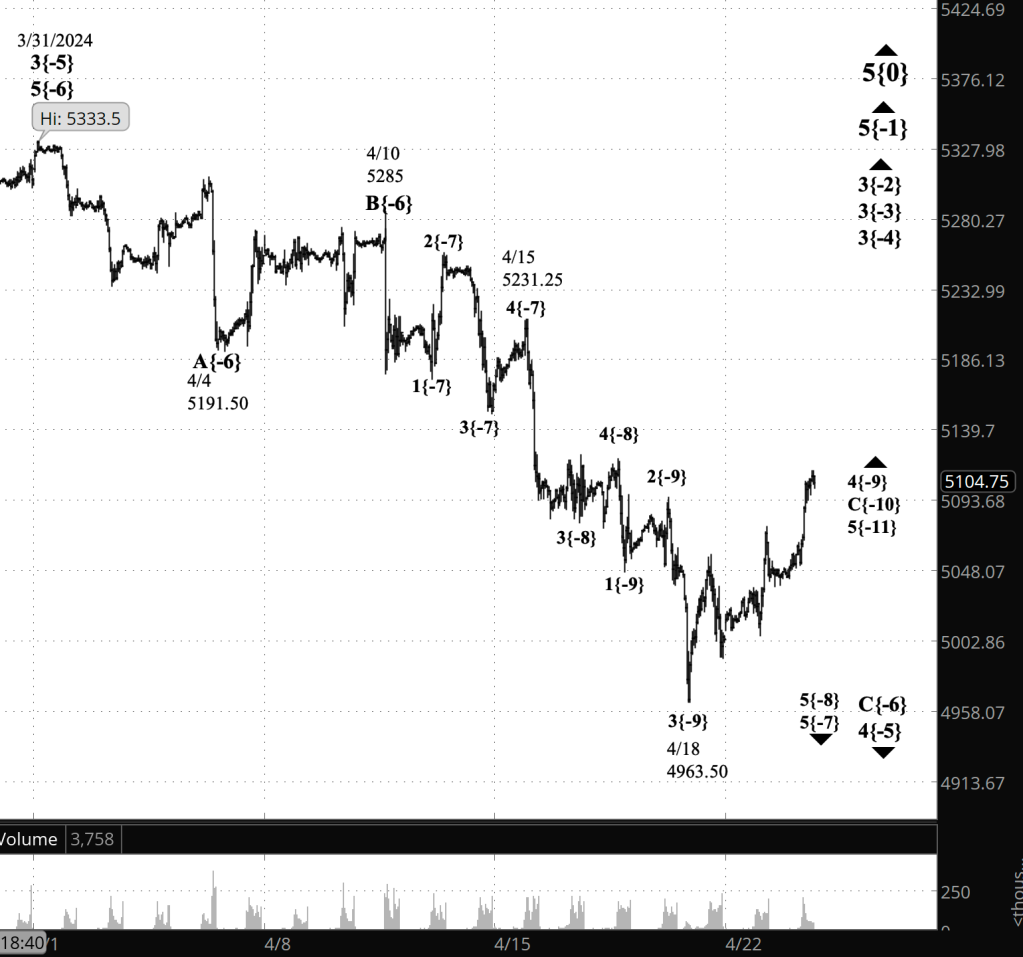3:30 p.m. New York time
Half an hour before the closing bell. The S&P 500 futures continued to rise during the session, breaking above 5110. In Elliott Wave Theory, the 4th-wave upward correction that began on April 18 is working through its end game, as described below in this morning’s analysis.
I’ve updated the chart.
9:35 a.m. New York time
What’s happening now? The S&P 500 E-mini futures rose overnight, from the 5030s to the 5060s.
What does it mean? Elliott Wave Theory sees the rise as a the third and final subwave — wave C — of a 4th-wave upward correction of low degree that began on March 18. Wave C will have five subwaves total and is presently in its 5th subwave.
On the chart the present position, smaller to larger, is wave 5{-11} within wave C{-10} within wave 4{-9}, with each wave number being followed by a subscript in curly brackets showing how many degrees removed the wave is from the Intermediate degree, presently a 5th wave that began in December 2018.
The low-degree 4th wave is buried four degrees deep within a larger 4th-wave downward correction — wave 4{-5} on the chart — which began on March 31. The end of the low-degree 4th wave (wave 4{-10}) will travel up the fractal structure and signal the end of the larger degree 4th wave (wave 4{-5}).
The larger 4th-wave downward correction will be followed by a 5th-wave uptrend that will end the 3rd wave (wave 3{-4}) that encompasses it and will begin a larger 4th-wave downward correction.
What are the alternatives? Often Elliott Wave Analysis comes down to the question, “Does it look right?”. The low-degree 4th-wave correction is larger than the comparable wave one degree larger. There’s no rule against it in Elliott Wave Theory. But still…

[S&P 500 E-mini futures at 3:30 p.m., 40-minute bars, with volume]
What does Elliott wave theory say? Here are the waves that underly the analyses.
Principal Analysis:
- Rising wave 5{0} is underway. It is a wave of Intermediate Degree that began in December 2018.
- It is in its final subwave, wave 5{-1}
- Within wave 5{-1}, rising waves 3{-2}, 3{-3} and 3{-4} are underway, as is the smallest wave labeled on the chart, wave 4{-5}.
- Downtrending wave 4{-5} is in its final subwave, falling wave C{-6}, which is in its last subwave, falling wave 5{-7}.
- Within wave 5{-7}, wave 5{-8} is underway and is in its next-to-the-last subwave, wave 4{-9}.
- Wave 4{-9} is in its final subwave, wave C{-10}, which in turn is in its fifth and final subwave, wave 5{-11}.
Reading the chart. Price movements — waves – – in Elliott wave analysis are labeled with numbers within trending waves and letters with corrective waves. The subscripts — numbers in curly brackets — designate the wave’s degree, which, in Elliott wave analysis, means the relative position of a wave within the larger and smaller structures that make up the chart. R.N. Elliott, who in the 1930s developed the form of analysis that bears his name, viewed the chart as a complex structure of smaller waves nested within larger waves, which in turn are nested within still larger waves. In mathematics it’s called a fractal structure, where at every scale the pattern is similar to the others.
Learning and other resources. Elliott wave analysis provides context, not prophecy. As the 20th century semanticist Alfred Korzybski put it in his book Science and Sanity (1933), “The map is not the territory … The only usefulness of a map depends on similarity of structure between the empirical world and the map.” And I would add, in the ever-changing markets, we can judge that similarity of structure only after the fact.
See the menu page Analytical Methods for a rundown on where to go for information on Elliott wave analysis.
By Tim Bovee, Portland, Oregon, April 23, 2024
Disclaimer
Tim Bovee, Private Trader tracks the analysis and trades of a private trader for his own accounts. Nothing in this blog constitutes a recommendation to buy or sell stocks, options or any other financial instrument. The only purpose of this blog is to provide education and entertainment.
No trader is ever 100 percent successful in his or her trades. Trading in the stock and option markets is risky and uncertain. Each trader must make trading decisions for his or her own account, and take responsibility for the consequences.
All content on Tim Bovee, Private Trader by Timothy K. Bovee is licensed under a Creative Commons Attribution-ShareAlike 4.0 International License.
Based on a work at www.timbovee.com.

You must be logged in to post a comment.